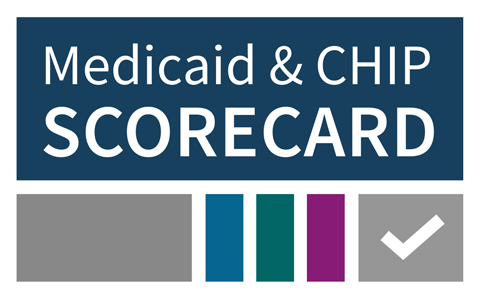
The Centers for Medicare & Medicaid Services (CMS) developed its Medicaid and Children's Health Insurance Program (CHIP) Scorecard to increase public transparency about the programs’ administration and outcomes. The Scorecard includes measures voluntarily reported by states, as well as federally reported measures in three pillars (State Health System Performance, State Administrative Accountability, and Federal Administrative Accountability). States and CMS can use the Scorecard to drive improvements in areas such as state and federal alignment, beneficiary health outcomes, and program administration.
The Scorecard also includes National Context data that explain how Medicaid and CHIP programs can vary across states. A summary of the Scorecard can be found in the Scorecard Fact Sheet (PDF, 118.32 KB).
Like Medicaid and CHIP beneficiaries, information in the Scorecard spans all life stages. CMS released the first Scorecard in June 2018. This version of the Scorecard includes additional health and program indicators and provides more information on how the Medicaid and CHIP programs operate.
The Scorecard will continue to evolve and will be flexible—CMS may add new areas of emphasis important to the Medicaid and CHIP programs or replace measures as more outcome-focused ones become available.
CMS works with a subset of Medicaid agencies and other stakeholders to select measures for the Scorecard. Many measures in the Scorecard come from public reports. For example, most measures in the State Health System Performance pillar come from the Child and Adult Core Sets. This approach allows CMS to align the Scorecard with existing reporting efforts.
Including measures from the Core Sets in the Scorecard builds on states’ investments in collecting and reporting these voluntary measure sets. While there are many reasons some states do not collect or report all Core Set measures, CMS hopes the Scorecard will draw attention to the importance of reporting on these measures. Core Set reporting methods also can vary among states. For example, some states report data on certain populations such as those covered under managed care, but not those covered under fee-for-service. This variation in data can affect measure performance and comparisons between states. Readers should review the detailed measure notes to better understand states’ reported rates.
The Scorecard also sheds light on important questions about the scope of Medicaid and CHIP. The National Context page presents data to answer the questions:
- Who enrolls in Medicaid and CHIP?
- How do states deliver care in Medicaid?
- What data are CMS and states developing to support program improvement?
- What are annual expenditures for Medicaid and CHIP?
- What is the rate of improper payments in Medicaid and CHIP?
States establish and administer their own Medicaid and CHIP programs. As a result, the populations and benefits covered by Medicaid and CHIP vary across states. For example, in all states Medicaid provides health care coverage for some low-income people, families and children, pregnant women, the elderly, and people with disabilities. In some states Medicaid also covers all low-income adults below a certain income level. This group is sometimes called “expansion adults.” In CHIP, states can choose to set income levels higher than the federal minimum threshold and to cover pregnant women. Federal law also requires states to provide certain mandatory benefits and allows states to cover other optional benefits in Medicaid and CHIP. States deliver Medicaid and CHIP benefits by directly paying providers – called “fee-for-service” payments – or through contracted arrangements with managed care organizations that oversee benefit delivery.
This version of the Medicaid and CHIP Scorecard was released in October 2020. To view the version of the Medicaid and CHIP Scorecard that was published in November 2019, please visit the archived Scorecard page.
